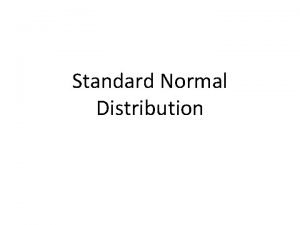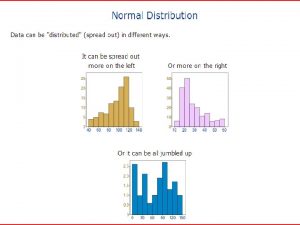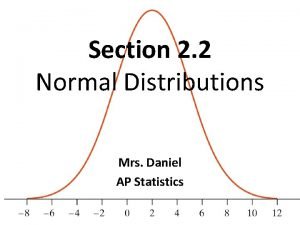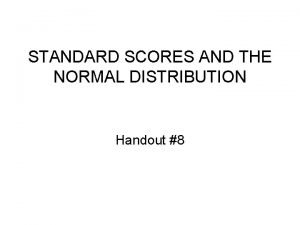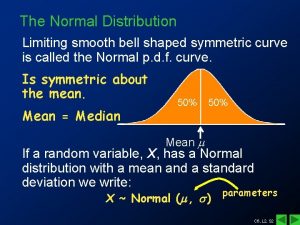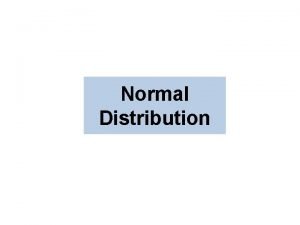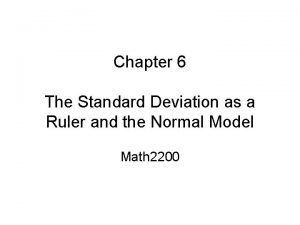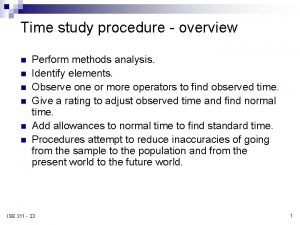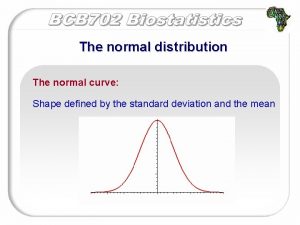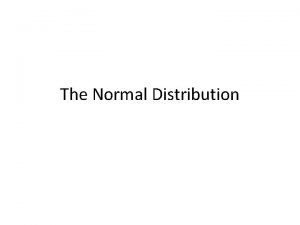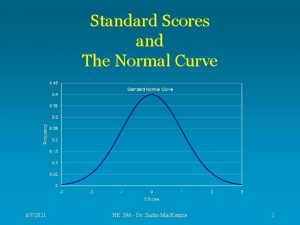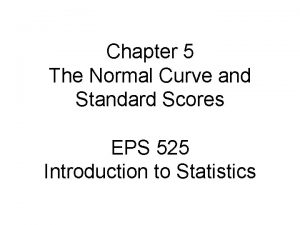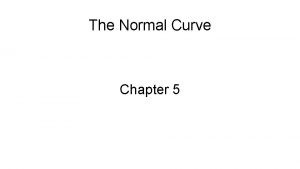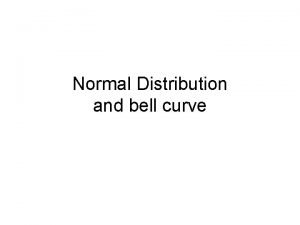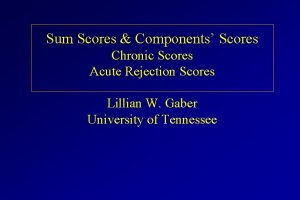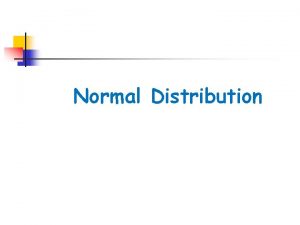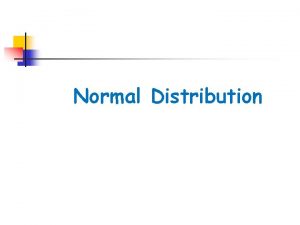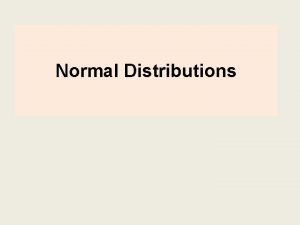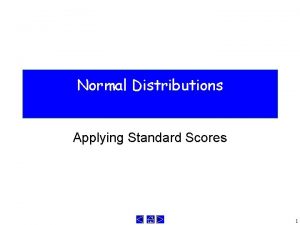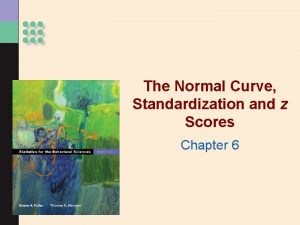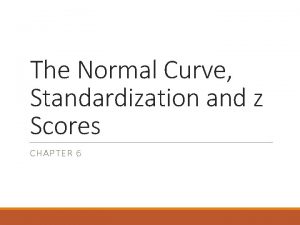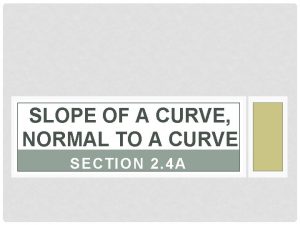Standard Scores and The Normal Curve 9162020 HK


















- Slides: 18

Standard Scores and The Normal Curve 9/16/2020 HK 396 - Dr. Sasho Mac. Kenzie 1

Z-Score • Just like percentiles have a known basis of comparison (range 0 to 100 with 50 in the middle), so does the z-score. • Z-scores are centered around 0 and indicate how many standard deviations the raw score is from the mean. • Z-scores are calculated by subtracting the population mean from the raw score and dividing by the population standard deviation. 9/16/2020 HK 396 - Dr. Sasho Mac. Kenzie 2

Z-score Equation • x is a raw score to be standardized • σ is the standard deviation of the population • μ is the mean of the population 9/16/2020 HK 396 - Dr. Sasho Mac. Kenzie 3

Z-score for 300 lb Squat • Assume a population of weight lifters had a mean squat of 295 ± 19. 7 lbs. • That means that a squat of 300 lb is. 25 standard deviation above the mean. This would be equivalent to the 60 th percentile. 9/16/2020 HK 396 - Dr. Sasho Mac. Kenzie 4

What about a 335 lb Squat • How many standard deviation is a 335 lb squat above the mean? • That means that a squat of 335 lb is 2 standard deviation above the mean. This would be equivalent to the 97. 7 th percentile. 9/16/2020 HK 396 - Dr. Sasho Mac. Kenzie 5

From z-score to raw score • A squat that is 1 standard deviation below the mean (-1 z-score) would have a raw score of? • What would you know about the raw score if it had a z-score of 0 (zero)? 9/16/2020 HK 396 - Dr. Sasho Mac. Kenzie 6

Z-score for 10. 0 s 100 m • Assume a population of sprinters had a mean 100 m time of 11. 4 ± 0. 5 s. • That means that a sprint time of 10 s is 2. 8 standard deviations below the mean. This would be equivalent to the 99. 7 th percentile. 9/16/2020 HK 396 - Dr. Sasho Mac. Kenzie 7

Converting Z-scores to Percentiles • The cumulative area under the standard normal curve at a particular z-score is equal to that score’s percentile. • The total area under the standard normal curve is 1. 9/16/2020 HK 396 - Dr. Sasho Mac. Kenzie 8

Histogram of Male 100 m 300 Frequency 250 200 150 250 100 250 150 50 0 300 150 50 <10. 0 50 10. 1 to 10. 5 10. 6 to 11. 0 11. 1 to 11. 5 11. 6 to 12. 0 12. 1 to 12. 6 >12. 7 Time (s) 9/16/2020 HK 396 - Dr. Sasho Mac. Kenzie 9

The Histogram • Each bar in the histogram represents a range of sprint times. • The height of each bar represents the number of sprinters in that range. • We can add the numbers in each bar moving from left to right to determine the number of sprinters that have run faster than the current point on the x-axis. • Dividing by the total number of sprinters yields the proportion of sprinters that have run faster. 9/16/2020 HK 396 - Dr. Sasho Mac. Kenzie 10

Proportion • For example, 50 sprinters ran less than 10. 0 s. • That means that, (50/1200)*100 = 4%, of the sprinter ran < 10. 0 s. • Notice that the area of each bar reflects the number of scores in that range. Therefore, we could just look at the amount of area. • If there a sufficient number of scores, the bars can be replaced by a smooth line. 9/16/2020 HK 396 - Dr. Sasho Mac. Kenzie 11

Male NCAA 100 m Sprint 300 Frequency 250 200 150 250 100 300 250 150 50 0 9. 8 10. 2 50 10. 6 11. 0 11. 4 11. 8 12. 2 12. 6 13. 0 Time (s) 9/16/2020 HK 396 - Dr. Sasho Mac. Kenzie 12

Male NCAA 100 m Sprint 300 Frequency 250 200 150 100 50 0 9. 8 10. 2 10. 6 11. 0 11. 4 11. 8 12. 2 30 16 12. 6 13. 0 Time (s) 97 90 84 70 50 10 3 Percentile 9/16/2020 HK 396 - Dr. Sasho Mac. Kenzie 13

Normal Distribution • If the data are normally distributed, then the raw scores can be converted into zscores. • This yields a standard normal curve with a mean of zero instead of 11. 4 s. 9/16/2020 HK 396 - Dr. Sasho Mac. Kenzie 14

Frequency Male NCAA 100 m Sprint -3 -2 -1 0 1 2 3 z-score (standard deviations) 9/16/2020 HK 396 - Dr. Sasho Mac. Kenzie 15

Male NCAA 100 m Sprint 50% Frequency 15. 9% 84. 1% Cumulative % 34. 1% 2. 3% 97. 7% 13. 6% 0. 14% -3 0. 1% 9/16/2020 13. 6% 2. 2% -2 2. 2% -1 0 1 z-score (standard deviations) HK 396 - Dr. Sasho Mac. Kenzie 2 99. 9% 3 0. 1% 16

Excel • The function NORMSDIST() calculates the cumulative area under the standard normal curve. • The function NORMSINV() performs the opposite calculation and reports the z-score for a given proportion. • NORMDIST() and NORMINV() perform the same calculations for scores that have not been standardized. 9/16/2020 HK 396 - Dr. Sasho Mac. Kenzie 17

Z-score and Percentile Agreement • Converting a z-score to a percentage will yield that score’s percentile. • However, the population must be normally distributed. • The less normal the population the greater discrepancy between the converted z-score and the percentile. 9/16/2020 HK 396 - Dr. Sasho Mac. Kenzie 18
 Typologies are typically nominal composite measures.
Typologies are typically nominal composite measures. T distribution table
T distribution table The area under a standard normal curve is?
The area under a standard normal curve is? Phi function table
Phi function table Itbs scores the normal distribution
Itbs scores the normal distribution Standard scores explained
Standard scores explained S curve and j curve
S curve and j curve S curve and j curve
S curve and j curve The normal curve is smooth and symmetric
The normal curve is smooth and symmetric Sigmoidal and hyperbolic curve
Sigmoidal and hyperbolic curve Lateral compensating curve
Lateral compensating curve How to calculate standard deviation from mean
How to calculate standard deviation from mean Chapter 6 the standard deviation as a ruler
Chapter 6 the standard deviation as a ruler Chapter 6 the standard deviation as a ruler
Chapter 6 the standard deviation as a ruler Definition of work study
Definition of work study Time study procedure
Time study procedure Desmos normal distribution
Desmos normal distribution Normal shape
Normal shape How does changing the mean affect a normal curve
How does changing the mean affect a normal curve


